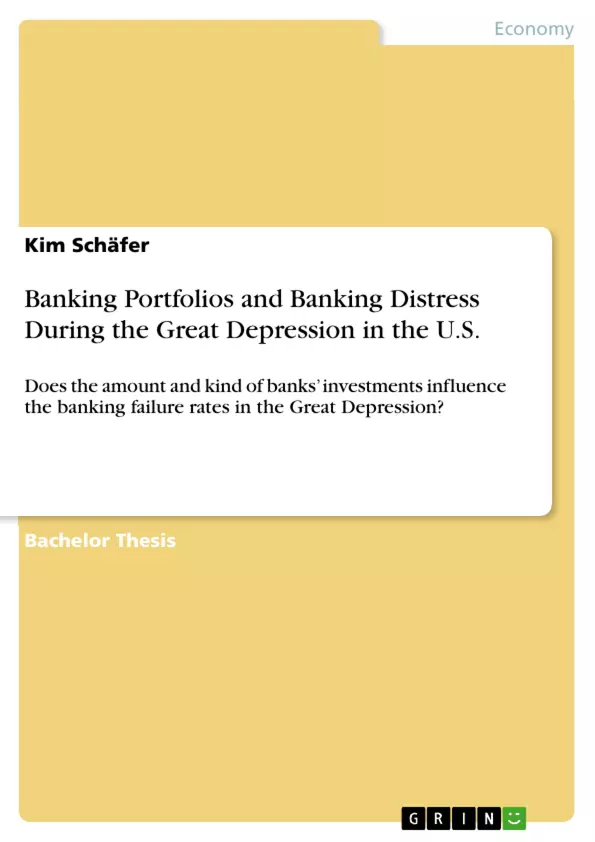The general structure of the United States’ banking system played an immense role in most of the theories explaining the reasons for the financial crisis and its subsequent banking failures of the Great Depression. Therefore, the paper starts with a brief explanation of the American banking system, its importance and the general structure, in order to prove sound previous knowledge to better understand the following theories.
In the third chapter a comprehensive overview of the financial crises during the Great Depression is given, all significant aspects that could have influenced or even triggered the financial crises are explained and defined, and different views of researchers are provided. The financial crisis’ main focus of the Great Depression was on the extraordinary high banking failure rates and therefore the main objective of this paper is to investigate whether it would have been possible to forecast the high failure rates on the basis of the bank’s balance sheets before the Great Depression or not. Therefore, a comprehensive definition, its emergence in connection with the Basel Accords, and different measurement methods are provided. Due to the fact that the economy has to face financial crises again and again it is time to figure out models that might forecast financial crisis. Therefore, characteristics of former financial crisis have to be analysed in a manner that tell whether it would have been possible to forecast banking failures. In this study it will be investigated whether banks’ balance sheet could be a foundation of such theories. For this reason, the study is subdivided into three major parts.
First of all, it is tested whether investments of banks influence banking failure rates at all by means of a regression model. In the second part of the study it is investigated whether banks in the United States were more likely to run illiquid or insolvent during the Great Depression. In order to come to a conclusion, the value at risk is compared to equity and working capital. Last but not least the study examines whether there is a “proportional connection” between banking failure rates and the value of risk, depending on the amount the banks invested in the different asset type. The conclusion will summarize all findings and link it to the literature of the paper.
Inhaltsverzeichnis (Table of Contents)
- Introduction
- Literature Review
- The American Banking System and Its Importance
- The Financial Crisis
- Value at Risk
- Empirical Part
- Dataset
- Study
- Conclusion
- Reference List
- Appendix
Zielsetzung und Themenschwerpunkte (Objectives and Key Themes)
This thesis aims to analyze the impact of banking portfolios and distress on the U.S. economy during the Great Depression. It explores the role of the American banking system, the financial crisis, and the concept of Value at Risk (VaR) in understanding the economic downturn.
- The structure and importance of the American banking system in the 1920s
- The causes and consequences of the financial crisis leading to the Great Depression
- The application of Value at Risk (VaR) in assessing banking portfolio risk during the crisis
- The impact of banking distress on the U.S. economy and its recovery
- The lessons learned from the Great Depression for modern financial systems
Zusammenfassung der Kapitel (Chapter Summaries)
- Introduction: This chapter provides an overview of the Great Depression, highlighting its historical context and significance. It discusses the rapid economic growth preceding the crisis and the factors that contributed to the downturn.
- Literature Review: This section explores relevant literature on the American banking system, the financial crisis of the 1920s, and the concept of Value at Risk (VaR). It examines key theories and research findings that inform the thesis.
- The American Banking System and Its Importance: This chapter delves into the structure and operation of the American banking system in the 1920s, emphasizing its importance to the economy.
- The Financial Crisis: This section examines the causes and consequences of the financial crisis that led to the Great Depression, analyzing the role of various factors such as speculation, overconfidence, and the Federal Reserve's policies.
- Value at Risk: This chapter introduces the concept of Value at Risk (VaR) and its application in assessing banking portfolio risk. It explains the methodology and its relevance to the study.
- Empirical Part: This section presents the empirical analysis conducted for the thesis, including the dataset used, the study methodology, and the findings.
- Dataset: This chapter describes the data sources and variables used in the empirical analysis, providing details on the data collection and preparation process.
- Study: This section presents the study methodology, explaining the research design, statistical techniques employed, and the analysis conducted.
- Quote paper
- Kim Schäfer (Author), 2015, Banking Portfolios and Banking Distress During the Great Depression in the U.S., Munich, GRIN Verlag, https://www.grin.com/document/316740



